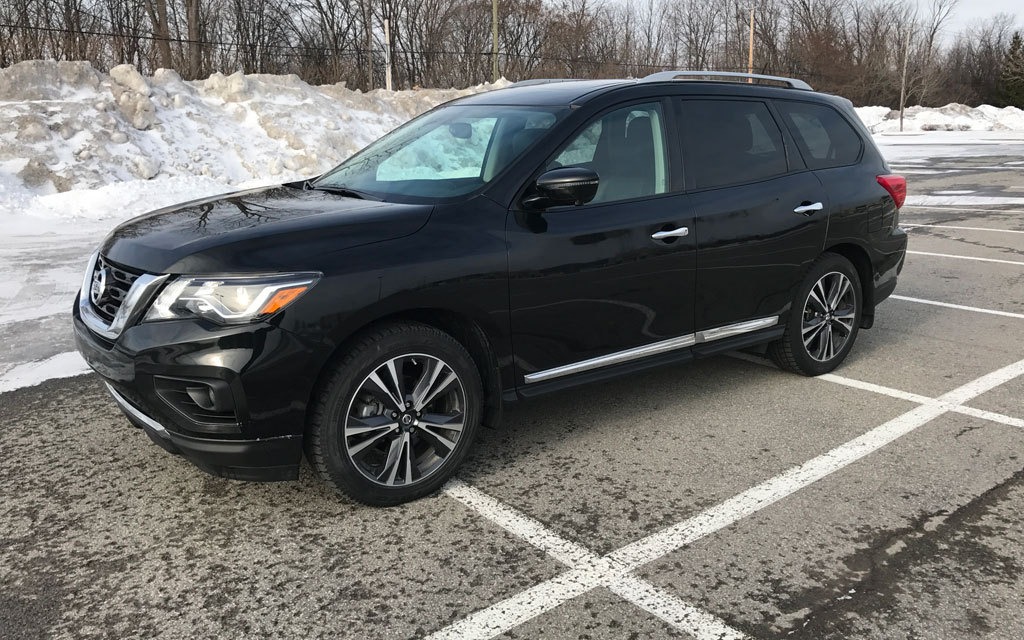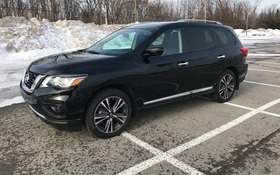2017 Nissan Pathfinder: Refreshed, but a Bit Rough Around the Edges

| Strong points |
|
|---|---|
| Weak points |
|
The Pathfinder is one of the more well-known names in the family SUV/crossover market given that it’s been around seemingly forever. It was originally introduced in 1986 as a body-on-frame SUV, but this latest fourth-generation is actually a unibody-construction crossover and shares its platform with the Nissan Altima, Maxima, Murano and Infiniti QX60.
The fourth-gen Pathfinder was released in 2013 and like clockwork, Nissan has facelifted it after four good years of service. For 2017, the vehicle receives a nice update to its exterior in order to keep things fresh including a new grille, hood, headlights and bumper. A similar refresh was applied to the rear taillights and bumper. I’d say this is definitely a positive thing because something didn’t sit right with me when I looked at the pre-facelift Pathfinder. The front grille bulged out and was too prominent. Now that it’s been rectified, the Pathfinder looks a little more modern, a little more handsome.
- Also: 2017 Nissan Pathfinder: Discreetly Capable
- Also: 2016 Infiniti QX60: The Pathfinder’s Luxury Sibling

The updated appearance incorporates the latest Nissan signature design elements introduced, including the new "V-Motion" grille and boomerang-shaped headlights with LED daytime running lights. New LED headlights are standard on the Pathfinder Platinum.
The exterior isn’t the only area to be updated, as the inside has been lightly reworked as well. The standard Advanced Drive-Assist Display located in the centre of the instrument cluster features additional infotainment and informational displays. The cupholders were modified and an extra USB port was added in the centre console.
What Nissan should have done, but didn’t, is update that odd-looking dash. The wood paneling on this trim is very old school and there is too much of it. Coupled with the uninspiring layout, I was not a fan of this interior at all, despite the functionality and ergonomics being very good. It just reminded me of something out of the late 1990s.
The Pathfinder’s three-row configuration makes it easy to haul many bodies at once and the ability to allow easy third-row row access, with a child safety seat remaining securely in place in the second row, is something the company pioneered a little while back. They call it “Latch and Glide” as part of their EZ Flex system and it’s since been mimicked by many competitors. Being able to slide the second-row seats can be very helpful for tall people who need more space. Similarly, I found cargo space to be quite generous even with the third-row seats up.
I was especially anxious to test out the rear-seat entertainment system, particularly because of the dreadful operation of the majority of systems on the market today. They are so difficult to operate it’s as if most manufacturers never test them on real-world families. Nissan’s system was one of the better ones and didn’t take too long to figure out.
Thankfully, it didn’t rely on the rear-seat occupants (usually toddlers) to start playback like a certain other Japanese manufacturer does and it didn’t require the use of earphones to hear anything playing on the screen like a certain German manufacturer does. There still seems to be an overabundance of caution in letting the front-seat occupants manipulate the movie. At one point I was driving and had to stop the vehicle and put the parking brake on just to get the system off of DVD playback, which is surely not by design. All in all, I’ll still give them higher marks versus the competition, but the bar here is very low.

Under the hood, we find more refinements including a revised 3.5-litre V6 engine that features more power, torque and towing capacity. Many parts have been altered or replaced, including the combustion chamber design, pistons and intake manifold. Power for the new V6 increases to 284 hp (from the previous 260 hp) and torque is now rated at 259 lb.-ft. (up from 240 lb.-ft.).
I found throttle response to be a bit on the slow side and the engine to be on the noisy side. Suspension and steering have been revised to be stiffer and more responsive, and there were definitely no issues in this department. The Pathfinder had a firm grip on the road and navigated my cratered neighbourhood snow-covered, ice-laden roads with ease.
The 2017 Nissan Pathfinder comes in four trim levels starting with the Pathfinder S. Standard features include an 8.0-inch colour display, SiriusXM satellite radio, Bluetooth connectivity, EZ Flex seating system, tri-zone automatic temperature control and backup camera. Next up is the SV which adds an intelligent key, an eight-way power driver's seat, leather-wrapped steering wheel and gear shift lever, rear sonar, fog lights, auto-dimming rearview mirror and remote start.
Pathfinder SL models include leather heated 1st- and 2nd-row seats, heated steering wheel, motion-activated power liftgate, surround view monitor with moving object detection, blind spot warning and rear cross traffic alert among other features.
Finally, the Platinum tester had options such as unique 20-inch alloy wheels, LED headlights, a Bose 13-speaker audio system, cooled front seats, woodgrain paneling, a dual panoramic moonroof, trailer tow package, forward emergency braking and intelligent cruise control.
The Pathfinder refresh will certainly help maintain its status as a must-drive for anyone looking for a midsized crossover.











